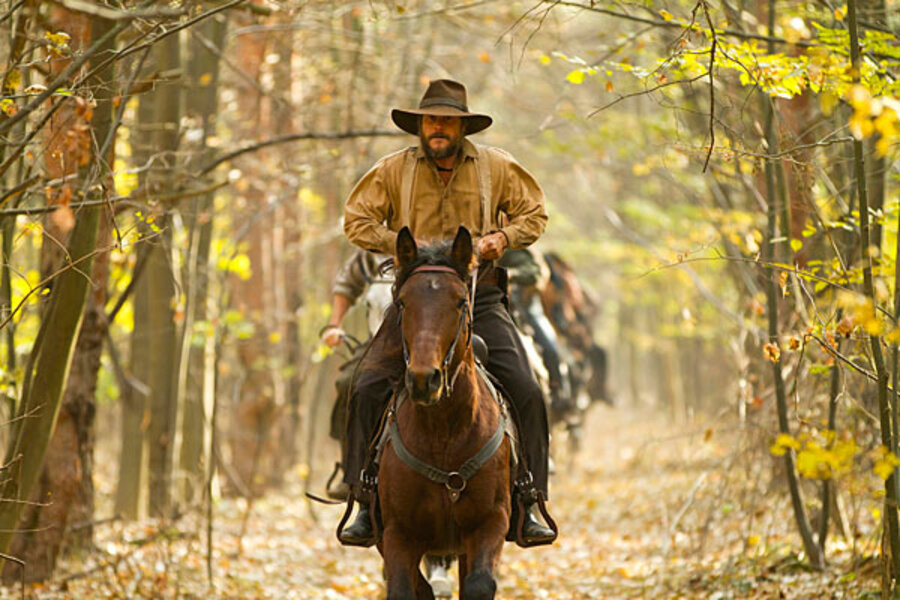How 'Hatfields and McCoys' became cable's biggest-ever hit
Loading...
| Los Angeles
The History Channel has put the violent “Hatfields and McCoys” on the cultural map with its three-night, six-hour miniseries event ending Wednesday.
But the show has also sent a shot across the larger television landscape with its stunning ratings its first two nights. According to early Nielsen numbers released by the network, some 13.9 million viewers tuned in Monday and 13.1 million on Tuesday, making it the first and second largest non-sport audiences ever for a basic cable show.
Put another way, NBC’s “America’s Got Talent” – a show that has consistently performed as the summer’s top-rated program and this year is drawing fresh attention for its new judge, Howard Stern – is drawing 10 million viewers.
“For a basic cable show to trounce the summer’s number one program is a big deal in the television world,” says Matt Whitfield, features editor of Yahoo! Entertainment. Expect not just a few knock-offs, he adds, but “any studio with a western or historical miniseries idea gathering dust on a shelf will give them another look.”
As the broadcast networks have increasingly relied on comedies and reality shows, cable has been leading the way into high-production value series, with big-name stars and budgets, beginning with HBO’s ”The Sopranos.” Since then, AMC’s “Mad Men,” TNT’s “The Closer,” and Showtime’s “The Tudors” have continued to escalate the trend. Showtime’s “The Borgias,” starred Jeremy Irons and the recently canceled racing drama “Luck” was directed by Martin Scorsese and featured Dustin Hoffman.
But while most of these series have been critical darlings, nabbing Emmys and Golden Globes, most also have suffered from ratings anemia. At the same time as “Mad Men” has been garnering top drama Emmys, it has languished with no more than some 4 million viewers. This ratings and critical home run for History demonstrates an approach that has been steadily redefining the TV landscape for the past dozen years, says Robert Thompson, founder of the Bleier Center for Television and Popular Culture at Syracuse University in New York.
What these niche channels – from HBO to Bravo to AMC – have done is use one hit to leverage the rest of the programming schedule. “Nobody had a clue where Bravo was until everyone wanted to watch ‘Queer Eye for the Straight Guy,’ ” says Professor Thompson. “Then they made the effort and found the channel on their dial, and the channel was able to promote the living daylights out of the rest of their shows.”
History tapped into the loyal audience that has been tuning into one of basic cable’s top reality shows, “Pawn Stars,” to cross-promote “Hatfields,” he says, and they turned out this huge audience that is unprecedented.
Thompson discounts the argument that this success is fueled by the fact that cable is not constrained by broadcast restrictions on language and content. “Look at NBC’s ‘West Wing,’ which was a critical and ratings hit,” he says. “People will tune in for a good show.”
The impressive turnout for a channel known not so long ago as the “World War II” channel also shows important facts about who is watching TV, says James Von Schilling, author of “The Magic Window: American Television, 1939-1953.” Kevin Costner and Tom Berenger “are stars from the 1980s, and fans from that era are rewarding the networks by tuning in.”
The miniseries drew some 5.8 million viewers among adults age 25 to 54, according to early numbers reported in the Hollywood Reporter.
“Young audiences have many more places they turn to from their phones to their iPads and laptops,” Mr. Von Schilling says. “This older audience is much more likely to be sitting in front of a television than a teen audience.”
This is event TV, and viewers should expect more of this sort of movie-style promotion, says Wally Podrazik, author of "Watching TV." The high production values, the big-name stars, and big budgets are all things people have come to expect no matter where they watch their entertainment, he adds.







